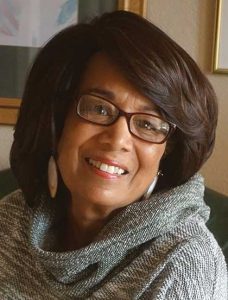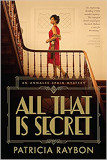
Q: You’ve written several books, but this is your first novel. How was your writing process different for this project?
A: One big surprise and difference: writing fiction demands bottomless courage—both for the writer and the characters. First, I was censoring myself—saying, “Nope, you can’t write that” or “You can’t say that.” But the more risks I took with the characters, their stories, and the writing itself, the more compelling, I believe, the overall story became. Another joy: my characters kept surprising me—showing up on the page when I hadn’t yet met them, doing things I hadn’t planned, revealing things I didn’t see coming. Writing my story was like watching cinema with plot twists. My husband, Dan, would hear me in my office suddenly yell out, “Guess what just happened!” I truly loved the writing process. As I’ve said to many friends, if I knew fiction was going to be so much fun, I’d have switched over to it years ago.
Q: What kind of research did you do as you began to write?
A: Big, small, and all. I love history. In fact, historical fiction lives and dies on historical accuracy. So I found myself poring over old Colorado newspapers from the 1920s, the era of my book. With thanks to Denver Public Library’s Western History Collection, I listened to oral histories, scoured old phone books, street maps, vintage photos, church bulletins. One surprise to me was that many white people in Colorado hated the Klan, a group whose support struck Colorado, said one observer, “like brush fire.” Meanwhile, small story details demanded attention: How much was a train ticket from Chicago to Denver in 1923? What perfumes were women wearing? Aftershave scents for men? Car models? Hit songs? Popular movies? I love history, so poring over this material never got old.
 Q: Where did the idea for All That Is Secret come from?
Q: Where did the idea for All That Is Secret come from?
A: From two places. First, I love “clergy” mysteries—Father Brown by G. K. Chesterton, Grantchester, and the like. My hope was to introduce a character wrestling with a faith conundrum into the crucible of a mystery, complicated by two additional things—race and a sometimes-rocky new relationship. Second, I wanted the setting to be Colorado, a beautiful “sunshine” place—but during one of its darkest times, the 1920s. The character who emerged to find her place in that world was young Professor Annalee Spain. Once I “met” her, her story began to emerge.
Q: This story explores themes such as bigotry, faith, self-acceptance, and love. What was it like weaving together so many different themes?
A: Life is complex for everyone. But for a young believer of color, the overlay of racial insult and the self-doubt and questioning of God that come with it make every single day a fight to keep moving—let alone solve a murder and wrangle a complicated but blooming relationship. Annalee’s story wouldn’t have been real, however, without all these colliding angles. To keep the ship steady, my job was to focus on what she wanted most—to figure out who killed her downtrodden father, especially when the suspects included upper-crust elites. Answering that question was the story’s North Star, but also hers. The other angles helped add the suspense, excitement, and depth I was seeking.
Q: Annalee’s story is fictitious, but many of the challenges she faces (such as prejudice and wrestling with God) are not. How did exploring these topics in fiction bring them to life in a new way?
A: The mystery context ignites these old topics in a new way. Here’s a prim young woman confounded by God while unraveling a collision of clues, perhaps falling in love and getting chased by bad guys. Then, in the middle of that, in walks bigotry—leading her to question God even more. But here come the bad guys again? Life doesn’t stop when you’re a target—or wrestling with your faith as a result. Such a challenge heightens story tension, but also makes Annalee relatable and her story exciting, but also hopeful. I’m praying that people deeply enjoy her response to all of it.
Q: Who was your favorite character to write?
A: Tough question! Answering is like picking a favorite child. Impossible. What I loved writing most was the relational tensions striking the characters—especially the growing attraction between Annalee and the young, strong-minded pastor Jack Blake. I loved writing their scenes because they affirm that, despite the raking hurt of bigotry and being a target of that, people still want to fall in love. I rejoice how their relationship—with its challenges and complications—deepens the novel, especially as a seed for the series.
Q: What are some of the unique challenges of writing a mystery? What about historical fiction?
A: The puzzle. Wow. In mystery, it’s everything. My wonderful editor at Tyndale, Sarah Rische, helped me wrestle “puzzle” to the mat, double-checking every angle. Just as critical is the need to add suspense, atmosphere, bad breaks, moral choices. Also in mystery, someone’s life gets taken. That invites a brave look at all things in life that die, spiritually, for each of us. What, indeed, can we learn about life by looking hard at dying? As for historical fiction, hindsight reminds us that winners write history. But what’s the rest of the story? Historical fiction allows a second look. Writing my novel helped me get in touch with both sides of a historical time and place.
Q: Annalee’s story is set during a dangerous historical era for Black people in America. What led you to explore that time in history?
A: For one, it’s still a dangerous time. Even so, how did people thrive back then under toxic conditions? My parents both managed to get college degrees at historically Black universities in the thirties but couldn’t drink water out of a “white” fountain. My family couldn’t stay in hotels during family road trips in the fifties or sixties. Or eat in restaurants or use public restrooms or get admitted to some amusement parks, libraries, beaches, pools, lunch counters. What happened in hearts and minds that made such demeaning rules okay? How does a young woman of the twenties find her life path in her own toxic time? Looking back allows answers for all of us.
Q: Aside from Annalee’s profession as a theology professor, how does faith play a role in this story?
A: If anything, Annalee is unsure of her faith and her ability to express it in her prayers, her hard choices, and in her life. Like most people, she knows she’s not a saint. So she’s on a journey with God, not yet arrived. But are her questions of God okay? Are her passions and desires acceptable? In her quiet times in the story, she asks such questions. Still, there’s no preaching. No drumbeating. No proselytizing. Yet her brave questions show the reality of wrestling with faith in our everyday lives, even though we might not understand everything about God. So that makes Annalee’s faith life—and her faith journey—like so many of us.
Q: What do you hope readers take away from this book?
A: A bigger heart. In fact, if I’m honest, I want readers to discover, as I did, that by experiencing a young, clever Black woman as fully dimensional, we open our hearts more to hidden aspects of ourselves. Life is rough-and-tumble. It can hit overdrive when family and secrets and race and love collide. But a tough, smart cookie can work on life’s mysteries and find answers—about herself and others—and then find the courage to tackle another puzzling problem again. I’m excited that readers will join me in following Annalee’s journey down that road. Together, we’ll discover more to unravel in her world, but also in our own.
Patricia Raybon



Leave a Reply